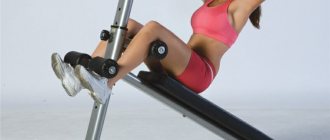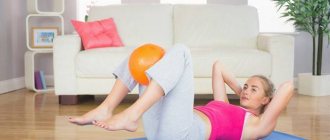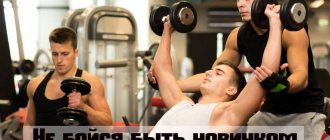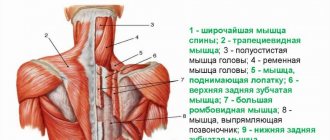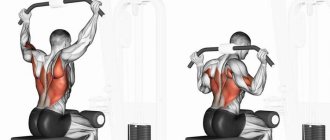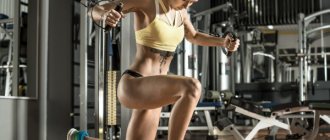Fat folds on the shoulder blades do not look aesthetically pleasing, and they also signal that you have weak back muscles - and this can lead to problems with the spine. Strong back muscles mean beautiful posture and a healthy spine. If your posture is incorrect and your back is slouched, then even thin girls may develop folds in the area of their shoulder blades.
How to remove fat from shoulder blades and back? Correcting your posture with the help of specially selected exercises helps remove wrinkles and make your figure slim.
We recommend reading: What is stress and how to cope with it
Doing only training on the back muscles, it is difficult to say goodbye to the fat folds on it. You can't lose weight in just one area. It is quite possible to get rid of wrinkles only using a set of measures.
Performing regular physical exercises on all muscle groups not only helps you lose weight, but also keeps your body in good shape. In addition, modern research claims that physical activity helps cope with chronic stress and prevents the development of depression. If you feel anxious, restless, insecure, or lonely, download our guide “How to Overcome Stress”, which will help you find inner answers and better understand yourself.
- Strong back muscles mean a healthy spine and correct beautiful posture. Poor posture not only worsens the aesthetic appearance, but also leads to improper load on the musculoskeletal system, which gives rise to local pain and a host of diseases. In a separate article, we shared several tips on how to maintain posture.
- Exercise helps increase the body's overall energy expenditure.
- Back training improves the “V-shape” of the figure, which helps to visually reduce the waist and allows you to achieve harmonious proportions.
- Maintaining muscle tone affects the functioning of internal organs.
For back pain, it was previously believed that the best treatment was bed rest, but this is fundamentally wrong. One of the best things you can do in this case is to continue moving and doing your normal activities.
A 2009 study did not confirm that spinal disc degeneration occurs primarily due to aging and wear and tear from mechanical damage and trauma. Instead, the process has been shown to be largely determined by genetic influences, although environmental factors also play an important role.
Swimming, yoga and Pilates also work well on the upper body. But suitable sets of useful exercises for the back can be performed at home, on the street and in the gym. To stay flexible and mobile, don't neglect stretching after exercise and warming up before you start.
Such exercises have the following goals:
1. stretching the spine;
2. strengthening the posterior muscles of the shoulders;
We recommend reading: Lower block pull-down to the waist
3. strengthening the stabilizing muscles between the shoulder blades;
4. stress relief;
5. elimination of protruding blades.
Exercise 1
Starting position: To perform the exercise, you need to lie on your stomach, put your feet shoulder-width apart, and your arms should be bent at the elbows and in contact with the floor.
- Raise your arms up, while bringing your shoulder blades together as much as possible.
- Concentrate on tension in your upper back.
- When performing the exercise, to achieve maximum results, the torso and arms should not leave the floor.
- Repeat 2-3 approaches, 15-20 times.
Exercise 2
Starting position: Take a pose lying on your back, bending your knees. The feet should be shoulder-width apart and the arms should be raised at right angles to the floor. In this exercise, it is important that your elbows are fixed and your arms are straight. The shoulder blades should be in contact with the floor.
- Arms straight, shoulder blades raised as high as possible from the floor. Pay attention to how close your hands are to the ceiling.
- Keeping your arms up, lower your shoulder blades until they touch the floor.
- Repeat the exercise several times, you can practice both fast and slow execution.
- After finishing, rest with your arms at your sides.
Exercise 3
We recommend reading: Lever traction on a simulator
Starting position: Stand with your back to the wall, leaning your back so that your heels, buttocks, shoulder blades and the back of your head touch the wall at the same time.
- Inhale, exhale. Straighten your chest without leaving the wall.
- You need to stand in this position for at least 5 minutes, if you can, stand longer.
Exercise 4
Starting position: Stand straight with your elbows slightly bent.
- Take a deep breath, and as you exhale, bring your shoulder blades together as close as possible to one another.
- Keep your head straight, looking straight ahead, continuing to breathe deeply. The duration of the exercise is 30 seconds, no more.
Exercise 5
Starting position: Position - lying on your back, on the floor. Raise your knees. The soles of your feet touch the floor shoulder-width apart. Arms are straightened, raised perpendicular to the floor, elbows are fixed. The shoulder blades are in contact with the floor.
- Having tucked the sacrum, feel how the feet are in contact with the floor. The chin should be retracted.
- Then, lower your chest while lifting your shoulder blades. After this, relax your sacrum, lower your shoulder blades, and place your arms at your sides.
- Repeat the exercise several times.
And the most important exercise that needs to be performed constantly is not to let fatigue and bad mood make you forget that your back should always be straight and your head cheerfully raised up!
published econet.ru. If you have any questions on this topic, ask them to the experts and readers of our project here
Calculate your ideal sports weight!
Did you like the article? Write your opinion in the comments. Subscribe to our FB:
Anatomy and structure of the latissimus dorsi muscles
The latissimus muscle is a superficial layer of the lower and partly the middle part of the back. It has a triangular shape. In sports, the term wings is often used for these back muscles, which is also related to the shape of the lats. They are considered one of the largest muscles in the body. The upper bundles have a lateral fiber direction and are partially covered by the trapezius muscle. The lower beams are directed obliquely, upward and to the side.
If you look at the photo of the latissimus dorsi muscles, you will see that it originates from:
- 5-6 lower thoracic vertebrae.
- 4 lower ribs.
- All sacral and lumbar vertebrae.
- Superficial layer of the thoracolumbar fascia.
- Sacral crest.
- Posterior part of the outer lip of the iliac crest.
The muscle is attached to the crest of the lesser tubercle of the humerus.
The direction of the muscle fibers is different, so exercises for the wings of the back should be selected taking into account the anatomical features. The upper beams have a predominantly horizontal orientation, and the lower beams have a diagonal direction.
How to pump up your back muscles.
Do you want to learn how to properly pump your back to make it wider, more massive and stronger?
You will learn about all this from our material. If you have long wanted to improve the thickness of your back muscles and strengthen your lats, but didn’t know where to start, then you have come to the right place!
You've probably heard a lot of jokes about athletes who "skip leg day." So, there is another part of the body that is not given due attention. This is the back.
For many people, it is an almost invisible and therefore forgotten muscle group. Unlike breasts, shoulders, arms and abs, they are not visible in the mirror. It's much easier to see biceps or six packs. But the most important thing is that you cannot see weak points in your back, even looking in the mirror. Fixing the problem is quite simple. Give your back the same attention as all other muscle groups and watch for weak spots.
Often, many beginners simply forget about it. Most people, when they first start training, find it difficult to include the lats in their work. Therefore, after making several sluggish approaches, they “score” on their backs and rush to move on to other exercises. Plus, when you look at yourself in the mirror, you can't see yourself from behind, so you can't fully appreciate your appearance.
Of course, no one is stopping you from doing it 5 days a week. However, as a result of such unbalanced training, you will look extremely disproportionate (and that's putting it mildly!).
- Improves your posture - you will no longer slouch, and your stomach will no longer protrude forward. Not only will good posture help you avoid back injuries, but it will also improve your overall well-being!
- Reduces Back Pain – Back pain can significantly reduce your quality of life. But if you perform the exercises without violating the technique, then back training will make it easier, or even completely relieve you of pain and discomfort in this part of the body.
- Makes your body proportionate – Regular training of these often overlooked muscle groups will help you achieve a proportionate and balanced physique.
- Will increase your attractiveness - believe me, it’s not just six-pack abs that make you sexy. A V-shaped physique also impresses women. And that's a fact.
To get into great physical shape, you first need to learn how to properly pump up your wings (or latissimus dorsi).
First things first, get off the couch and hit the gym. And finally, stop doing just that non-stop. It's time to focus on the weakest area of your body.
Anatomy of the back muscles
Lower back (lower trapezius and erector spinae)
Function:
- The lower part of the trapezius acts on the scapula bone and is responsible for adducting the scapula towards the spine. While the erector spinae muscle straightens the spinal column and keeps the torso in an upright position.
Where is :
- at the bottom of the shoulder blades
How to pump up your lower back:
- hyperextension exercises
- forward bends with a barbell on the shoulders (“Good morning”)
Middle back (rhomboid dorsi)
Function:
- these muscles ensure the movement of the scapula towards the spine and upward.
Where is :
- attaches to the shoulder blades and spine in the middle part of the back, located under the trapezius muscle.
Exercises for the middle part of the back:
- Bent-over barbell row
- pull-down block to the belt while sitting
Latissimus dorsi muscles
Function:
- moving the arm down and back, relaxing the shoulder girdle, bending the torso to the side. These are the largest muscles of the back. They are responsible for the notorious V-shaped body, so pay special attention to them!
Where is :
- occupies the entire lower part of the back, with its upper part coming under the lower end of the trapezius muscle.
How to pump up the latissimus dorsi muscles:
- pull-ups
- seated wide-grip vertical pull-down
Trapezius (trapezius muscles)
Function:
- this is a group of muscles that brings the scapula closer to the spine, is responsible for the movement of the neck, shoulders and supports the head.
Workout Features
Although training the latissimus dorsi muscles is quite simple and requires only an understanding of the basic functions to maximize effectiveness, many athletes neglect the basic rules. This reduces the overall benefit of exercise and slows progression. To pump up the latissimus dorsi muscles, it is recommended to follow a number of basic rules that are related to the specifics and characteristics of the group:
- When performing traction movements, it is necessary to prevent swaying of the body (in exercises, “swinging” of the body is allowed no more than 10 degrees. This contributes to better stretching of the muscle at the peak point).
- When performing exercises for the latissimus dorsi muscles, it is necessary to exclude the use of hands as much as possible (use them only to support the weight).
- The ability to focus on the group being worked on is important. The ability to contract your lats even at rest is the first step towards increasing the effectiveness of your training.
- Movements are performed only in full amplitude (with the exception of some exercises and techniques, for example, static dynamics).
- To pump the latissimus dorsi muscles, you need to work with heavy weights and high load intensity.
The back lends itself well to high-volume training. You can perform at least 10 failure sets of lat exercises, and the average work range per workout can range from 13 to 25 sets without the risk of overtraining.
The main thing is to be able to concentrate the load so that in back exercises in the gym the latissimus muscles take on the main load.
The process of preparing for basic training
If you have never seriously engaged in fitness or bodybuilding before, then before you begin the actual strength exercises for the back muscles, you need to devote 5 to 7 days to preliminary preparation.
This will make the process safer, help avoid injuries during further exercise and pump up muscles more effectively.
During the first preparatory week, you need to pay special attention to warming up before training, stretching your muscles, and strengthening exercises that do not put a lot of stress on your back. You can exercise at home without any additional equipment or only with light weight dumbbells (if you have them).
Recommended exercises to strengthen your back muscles include:
- Hyperextension or bending the back back.
- Raising straight legs from a horizontal position while lying on your stomach.
- Push ups.
- Raising dumbbells overhead.
- Stretching.
Perform these exercises 10-20 times in 2-3 sets every day for a week.
When your soreness goes away and you feel that this complex no longer poses any difficulty, you can begin basic exercises that will help directly pump up the latissimus dorsi muscles.
Top 4 exercises for the latissimus muscles for the gym and at home
In sports, there are 4 main types of exercises for the latissimus dorsi muscles with dumbbells, barbells and other equipment. Each type has many variations of execution that allow you to change the nature of the load to avoid muscle adaptation. These 4 exercises are fully enough to pump up your lats.
Pull-ups
Ultimate and basic movement for working out the entire group. It is deservedly considered the best exercise for the latissimus dorsi muscles. If you have a weak level of physical fitness, you can perform it with the support of rubber bands (or use lightweight techniques, such as horizontal pull-ups).
Technique:
- Hang from the horizontal bar, holding the handles (or bar) with an overhand grip, slightly wider than shoulder-width apart.
- Begin to pull your body up using your back muscles (at the top point, your arms and shoulders are more involved in the work).
- As soon as your chin crosses the line of the bar, pause and return to the starting position.
- At the lowest point, it is important not to spread your shoulder blades or relax your shoulders, as this can increase the risk of injury.
- Use the grip that allows you to make the movement cleanly and without jerking (with greater development of the biceps, when the triceps becomes a limiting factor, you can master the technique with a reverse grip).
Read more about pull-ups for back muscles →
Bent-over row
It can be used in different variations, but the specificity of the exercise is the same. For variety, you can alternate options:
- Bent-over row with a barbell.
- Alternately with dumbbells with emphasis on the bench..
- Together with dumbbells.
- With rubber band/expander.
- With bottom block.
- In the Smith machine.
- The technique for each exercise will be different, but in all movements it is important to perform the pull using the back , not the arms (the arms only engage when bringing the weight to the body).
- also important to exclude any inertia . Unlike other types of rods, the body must be fixed.
Vertical block thrust
Although this movement is often called a “pull-up replacement,” it is actually incredibly effective. Taking into account the fact that a huge part of athletes (and almost all beginners) cannot do full pull-ups, working with the upper block becomes one of the best among all exercise machines for the latissimus dorsi muscles.
Technique:
- Take the (long) handle with a wide grip and lower yourself onto the seat. The back should be straight, the elbows should be pulled straight to the sides (for the correct position of the shoulder and arm).
- Start pulling the handle towards you without changing the position of your body. The pull is carried out to the upper chest.
- To avoid damaging your nose or face, your head can be pulled back when lowering the handle (no more than 2-3 cm).
- Pause at the bottom and return to the starting position.
Read more about vertical block traction →
Horizontal rods
The peculiarity of these movements for pumping the latissimus dorsi muscles lies in the position of the body. In the lever pull, it is securely fixed and any swinging is excluded - the load will fall on the target muscle. In block deadlifts, on the contrary, it is recommended to swing the body a little, in the range of 10 degrees. This allows for a better stretch of the lats while abducting the handle.
Technique for performing horizontal traction (in a block):
- Sit on the bench and grab the handle so that the cable is taut in the starting position.
- Begin to pull the handle towards your lower abdomen, straightening your shoulders in parallel.
- Pause and return the handle to the starting position (bend your shoulders forward a little to stretch the muscles).
In the exercise, it is important to avoid rocking the body, rounding the back, and pulling with the arms and shoulders.
Exercises for home
In most cases, exercises performed at home for the latissimus dorsi muscles will be a replacement or alternative to movements from the gym:
- Pull-ups - there is nothing to replace them at home; they are performed only with a horizontal bar.
- Horizontal pull-ups – TRX loops, gymnastic rings.
- Vertical traction – in the presence of a horizontal bar and a harness (which will provide tension and the required load).
- Bent-over rows - using dumbbells, a tourniquet, a sandbag, or even a bottle of water or sand (the movement technique does not change).
- Horizontal traction - only with a tourniquet.
These options allow you to completely replace all movements and efficiently work out the lats without losing efficiency.
What about deadlifts?
Separately, it is worth noting the deadlift. This is a technically complex exercise for the latissimus dorsi muscles for men, which is very popular. It is a mistake to use it to load the lats, because the upper back does most of the work. The lats are loaded primarily in the lower part.
Back training depending on the training goal
Anatomy of the back muscles
Training your back in the gym, on the street and at home depends on your goals. A bodybuilder about to perform needs maximum muscle definition, a weightlifter needs strength, a gymnast needs functionality and flexibility, an amateur needs a beautiful appearance, a sick person needs relief from pain. Training is selected according to goals.
They consist of a set of exercises aimed at achieving a certain effect. A monthly plan is drawn up, alternating types of training. Exercises with iron or on a machine are the same for men and women.
Power
Aimed at developing strength. Its target is the long back muscles. High-threshold fast fibers that operate in the glycolytic mode develop. The main source of energy is creatine phosphate, so the duration of the movement itself is minimal - up to 10 s. The exercise provides some relief, but for a weightlifter or powerlifting enthusiast this is secondary.
Mass collection
Working with the latissimus dorsi
The latissimus, rhomboid and other superficial muscles work more. Fast muscle fibers are involved, working in a glycolytic mode, partly in an oxidative mode. The source of energy is glucose in muscle tissue and blood. The muscles are under load longer - more than 10-20 s, more repetitions - from 5 to 10 in each approach. This option provides maximum muscle pumping.
Mass-building training is the basis of training for bodybuilders. However, even those involved in rhythmic gymnastics, and even more so track and field athletes, often resort to such training, since they need muscle mass, and it is impossible to achieve muscle pumping in any other way.
Volume or for tone
Fast and slow fibers work in different modes. The main source is fatty acids. Volumetric training is very important for people with musculoskeletal injuries. Most movements in everyday life are performed with little effort - with slow muscles. With high repetitions - up to 20-25 repetitions with light weights - these are the ones that are pumped up. This frame ensures a stable position of the spine.
Stimulating or mental
Working with a barbell develops coordination.
It is aimed at developing the neuromuscular connection between the brain and muscle fibers. Performed in the gym or at home at any time of the day. No weight is needed, but you can take an empty bar: the athlete repeats the movement to get a feel for the technique and get rid of the clamps. Videos are a good help. Stimulating exercises can be repeated every day.
Mental training can be turned into strengthening your back. To do this, the athlete repeats the movement and imagines the effort with which he lifts the weight.
Tendon training
It is classified as stimulating, but is aimed at developing tendons. It is important for all practitioners, since poor functioning of the ligaments and tendons limits the amplitude. Can be performed at any time.
Technical
Can include any type of exercise. Its goal is to pump up a specific lagging muscle group. Practiced by all athletes.
Special training
In case of poor posture, exercises are performed in a horizontal position.
Designed for people with diseases of the musculoskeletal system. In this case, it is impossible to restore normal function of the back without weights. At the same time, during illness, these muscles quickly weaken or become hypertonic and become a source of severe pain. But their condition and functionality can only be restored through work.
Special training for patients with scoliosis, protrusion, osteochondrosis, and even fractures includes lighter versions of the same exercises. Since in case of soreness and great weakness of the muscles, a large load is excluded, they do not even exercise with weights, but with elastic bands or on a crossover. This type of tension pumps up the muscle along its entire length and very smoothly. Injuries are excluded, since the performer himself regulates the degree of tension of the elastic band.
Special training is carried out for rehabilitation purposes - after a fracture or other injury. Elastic bands are also used in the gym.
Combining different types of classes for the same group must take into account compensation. 2 mass-building workouts per week for the same group are not allowed. Strength and mental, strength and volume combine perfectly and can follow each other.
Broadest program
- Warm up – 5 minutes.
- Pull-ups – 5* to failure.
- Bent-over barbell row – 4*8.
- Horizontal thrust in the block – 4*10.
- Bent-over dumbbell row – 4*10.
- Lever rod (alternately with each hand) – 4*10.
- Muscle stretching.
How to pump up a girl's back. How can a girl build up her back muscles at home?
Have you ever refused to wear a beautiful dress with a cutout at the back because that particular part of your body didn’t suit you? Or maybe you have noticed the habit of slouching? Or perhaps you have started to experience back pain.
Any of these signs indicates that it’s time for you to turn your attention to your back, or rather to your muscles, so in today’s article we’ll talk about how to pump up a girl’s back at home.
Why is it so important to pump up a girl’s back muscles?
In today's world, it's difficult to keep track of everything. So many girls and women do not have time to monitor their posture. If you have not been taught to keep your back perfectly straight since childhood and you have not developed a muscular corset, then you cannot boast of beautiful posture.
But a straight back, a long beautiful neck and a proudly raised chin are integral attributes of the ideal image of a woman for all men. It's never too late to start correcting your posture.
This will lead to stronger back and neck muscles, which will thank you very much in the future. The fact is that the back muscles are involved in almost any of our movements, be it squatting or simple walking, not to mention lifting anything.
Therefore, if you have weak back muscles, sooner or later they are overloaded from heavy bags or long walking, and the overloaded muscles hurt. Lower back pain is much more common in women than in men. Agree, not the most pleasant feeling. In addition, a well-developed back visually reduces the waist and also restores the correct proportions between the upper and lower parts of the body.
Simply put, if your hips and buttocks are larger than your chest and shoulders, which is very common, then a pumped up back will make your body much more proportionate and attractive. We will tell you about exercises that will help any girl easily pump up her back at home. After all, not everyone has free time that you would agree to spend at the gym.
The best exercises for back muscles in the gym
Deadlift
Seated block row
Bent-over T-bar row
One-arm rows
Bent-over barbell row
The best exercises to train your back muscles at home
The main thing in women's back training is not to overdo it. It’s worth repeating all the exercises 15–20 times and ending each of them with a little stretching. This will allow you not to pump up your back before drawing out the muscles, but will tighten your muscle corset and tone your back muscles.
1. So, in order to pump up a beautiful back for a girl at home, you need to start with stretching, since it needs to be repeated most often. Exercise helps improve posture. From a position lying on your stomach, lift your torso with your arms and stretch up and slightly back.
If this is easy for you, then you can bend your knees and try to reach your thrown back head with them.
2. The next exercise is also performed while lying on your stomach. Place your hands behind your head. Raise your upper body as high as possible, and try not to lift your legs off the floor. At first you are unlikely to succeed, so you can ask someone to hold them or just slide your feet under the sofa, for example. Perform 10 times in 3 approaches.
3. Another posture exercise is performed while sitting on the floor. Cross your legs and put your hands behind your back and lock them together. Your arms should be straight. Turn your torso left and right. So 3 sets of 25 times.
4. To strengthen your back you need to do appropriate exercises. For one of them you will need weights. Take a dumbbell in your hand. Starting position: stand straight. Lean forward as low as possible to create a 90% angle and straighten up. So repeat 10-15 times for 3 approaches.
5. Another useful exercise. Lean your body forward, trying to create a 90-degree angle. Keep your legs straight. Hands in the starting position are lowered down. Raise your arms to the sides or back, hold, lower. 3 sets of 12 times.
That's all! Agree, very easy and simple, and also a few exercises. But thanks to them, you will get a smooth, beautiful back, a long neck, you will be able to open your shoulders and not be embarrassed to wear open dresses.
Isolation exercises for the back
The purpose of this complex is to strengthen muscles and is done at the end of the lesson. Thanks to this, those fibers that “rested” during the execution of the main elements are included in the work.
Exercises with weights
Bent over dumbbell lift with one arm
It is aimed at working not only this muscle group, but also the trapezius, biceps and forearm.
- Place a dumbbell in your right hand with a parallel grip. From the bench, stand on your left side with your feet together.
- Stand with your torso parallel to the floor and your back slightly arched at the waist. Straighten your arm with the dumbbells, slightly lowering your shoulder.
- Taking a deep breath, lift the dumbbell as high as possible, feeling the tension in your back and deltoids.
- When your elbow is at shoulder level, lift your shoulder. This promotes increased work of the mid-back and latissimus muscles.
- Hold the dumbbell in this position for 2-3 seconds. As you exhale, lower it down.
Repeat 8-12 times for the right hand. The same number of repetitions for the left. Perform 3-4 approaches.
Lifting the barbell to the waist
The main focus of this exercise is on the psoas and latissimus muscles.
- I.p. – feet shoulder-width apart. Take the barbell with a wide overhand grip.
- Bend your knees and lean forward. The bar hangs freely in outstretched arms. Arch your back a little.
- Raise the barbell to the level of your stomach and lower it.
Do 8-10 lifts in 3-4 sets.
T-Bar Raise
- Place a barbell with weights between your legs. Grasp the bar.
- Bend at an angle of 45º, feeling the tension in the muscles of the core and lower back, while keeping your back straight.
- Pull the bar toward your chest, tensing not only your lats, but also your trapezius muscles. Hold the barbell for 1 second, then slowly lower the barbell.
Do 10 lifts in 3-4 sets.
Pullover lift with dumbbell
- I.p. - lying on a bench. Hold the dumbbell at arm's length above your chest. Press your palms against the top disc.
- Using your back and lower back muscles, lower the dumbbell behind your head so that it is just below the bench.
- Arms should be straight. Raise the dumbbell into a standing position, using the latissimus dorsi muscles.
Do 8-10 lifts for 3-4 sets.
Exercises on simulators
Horizontal pulldown of the lower block from a sitting position
- Perform movements connecting your shoulder blades. Each rep, pull the V-shaped brace toward your waist.
- If you choose a narrow grip option, release the weight for 2-3 counts. Keep your back straight to reduce stress on your lumbar spine.
- This exercise not only makes your back muscles more prominent, but also helps improve your posture.
One-arm horizontal pulldown from a sitting position
In addition to this group of back muscles, stabilizer muscles are actively involved in this exercise.
- The D-shaped handle should be at chest level. Keep your back straight, look straight ahead. Press your feet against the supports with all your might.
- Using a parallel grip, grab the handle with one hand, with the other resting on your thigh. Pull the handle back, moving your elbow behind your back. Make sure your body remains motionless.
- Stay in this position, focusing on tensing the muscles of your back and shoulder. Then return to and. P.
Perform 10-12 repetitions of 3-4 sets.
Wide grip lat pulldown at an angle
The 30º row is a classic exercise for increasing back muscle mass.
- I.p. – sitting on a bench facing the machine. Grasp the handle with an overhand grip, placing your palms slightly wider than shoulder-width apart.
- At an angle of 30º, lean back relative to the vertical line. Tilt your chest slightly forward and keep your shoulders back. Hold this position for a few seconds.
- Start pulling the handle until it touches your chest. The shoulder blades should be retracted. Return to i.p.
Do the exercise 8-10 times for 3-4 approaches.
One-arm horizontal row with added rotation
By adding a rotation element to the exercise, you engage the shoulder stabilizer muscles and improve overall upper back development.
- I.p. – while sitting, place the handle in the shape of the letter D at stomach level. Keep your back straight.
- With your right hand, grab the handle with an overhand grip. Place your left hand on your thigh. Legs should be slightly bent at the knees.
- As you exhale, pull the handle, moving your shoulder blade back. At the same time, rotate the body. Hold this for 1 second, then take an i.p.
Do 8-10 repetitions for 3-4 sets.
Rules for training back muscles
To make the exercises effective, follow simple rules that will increase the effectiveness of the exercises:
- The Big Three Rule. There should be three main exercises in the training cycle: deadlift;
- barbell or dumbbell rows;
- pull-ups.
- start the movement by moving your shoulder back;

